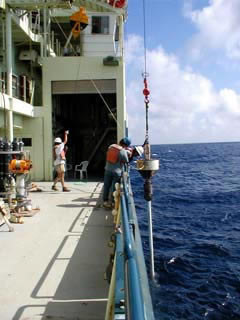The ocean's big bad burp
May 12, 2007
Courtesy of Far North Science
By Doug O'Harra
Here's one climate nightmare: Melting permafrost releases vast quantities of methane into the air, triggering a runaway greenhouse effect that accelerates global warming.
 Researchers using sophisticated research vessels
extract deep-sea sediment cores from oceans
around the world to chart past climate change.
Credit: UCB Researchers using sophisticated research vessels
extract deep-sea sediment cores from oceans
around the world to chart past climate change.
Credit: UCB
Or how about this? A shift in ocean currents and deep-water temperatures suddenly frees billions of tons of carbon dioxide. It essentially fizzes into the sea and gives the Earth's atmosphere a greenhouse jolt that makes recent warming seem chilly.
This is not some bad science fiction plot summary. Climate scientists at the University of Colorado Boulder have found evidence of two colossal global-wrenching "burps" that earped up from the deepest ocean near the end of the last ice age.
In Marine Radiocarbon Evidence for the Mechanism of Deglacial Atmospheric CO2 Rise, published this week in the online edition of Science, the Colorado team traced the origin of the 600 billion tons of carbon suddenly released into the air about 18,000 and 13,000 years ago.
That's twice as much carbon dioxide as what humans have managed to produce through burning fossil fuels over the past few centuries.
The new study shows that this carbon - built up and stored in the oceans over many thousands of years - bubbled up into the upper layers and into the air during "two big pulses," according to Thomas Marchitto and Scott Lehman of CU-Boulder's Institute of Arctic and Alpine Research, who jointly led the study.
The study marks the first time scientists have actually tracked the gas from its submarine layers up to the upper ocean and on into the air.
"This is some of the clearest evidence yet that the enormous carbon release into the atmosphere during the last deglaciation was triggered by abrupt changes in deep ocean circulation," said Marchitto, in a news release from UC at Boulder.
While much of the CO2 released by the oceans after the end of the last ice age about 19,000 years ago was taken up by the re-growth of forests in areas previously covered by ice sheets, enough remained in the atmosphere to pump up CO2 concentrations significantly, the authors said. Today, CO2 levels are higher than at any time in at least the past 650,000 years because of increased fossil fuel burning.
"The timing of the major CO2 release after the last ice age corresponds closely with deep-sea circulation changes caused by ice melting in the North Atlantic at that time," said Lehman. "So our study really underscores ongoing concerns about the ocean's capacity to take up fossil fuel CO2 in the future, since continued warming will almost certainly impact the mode and speed of ocean circulation."
The team analyzed sediment cores hauled from the Pacific Ocean seafloor at a depth of about 2,300 feet off the coast of Baja California using an isotopic "tracer," known as carbon 14, to track the escape of carbon from the deep sea through the upper ocean and into the atmosphere during the last 40,000 years. Extracted from the shells of tiny marine organisms known as foraminifera - which contain chemical signatures of seawater dating back tens of thousands of years - carbon 14 is the isotope most commonly used to radiocarbon date organic material like wood, bone and shell.
They found the carbon 14 "age" of the upper ocean water was basically constant over the past 40,000 years, except during the interval following the most recent ice age, when atmospheric CO2 increased dramatically. The study shows the carbon added to the upper ocean and atmosphere at the end of the last ice age was "very old," suggesting it had been stored in the deep ocean and isolated from the atmosphere for thousands of years, said Marchitto.
"Because carbon 14 works both as a 'tracer' and a 'clock,' we were able to show that the uptake and release of CO2 by the ocean in the past was intimately linked to how and how fast the ocean circulated," said Marchitto.
Humans have pumped an estimated 300 billion tons of carbon into the atmosphere since the Industrial Revolution, and the oceans have taken up about half of it, said Lehman.
"If the oceans were not such a large storage 'sink' for carbon, atmospheric CO2 increases in recent decades would be considerably higher," he said. "Since the uptake of CO2 on Earth's land surface is being offset almost entirely by the cutting and burning of forests, any decrease in the uptake of fossil fuel CO2 by the world's oceans could pose some very serious problems," Lehman said.
"When the ocean circulation system changes, it alters how carbon-rich deep water rises to the surface to release its carbon to the atmosphere," said Interim Director of INSTAAR Jim White, a climate scientist who was not involved in the study. "This is important not only for understanding why glacial times came and went in the past, but it is crucial information we need to understand how the oceans will respond to future climate change."
 Most of Far North Science is written and edited by Doug O'Harra, a writer and journalist based in Anchorage, Alaska.
Most of Far North Science is written and edited by Doug O'Harra, a writer and journalist based in Anchorage, Alaska. |
|


 Researchers using sophisticated research vessels
extract deep-sea sediment cores from oceans
around the world to chart past climate change.
Credit: UCB
Researchers using sophisticated research vessels
extract deep-sea sediment cores from oceans
around the world to chart past climate change.
Credit: UCB